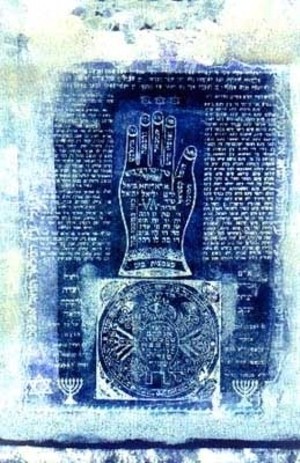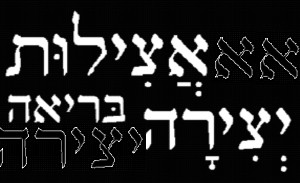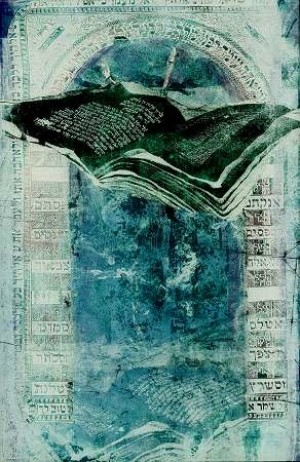Is Kabbalah Mysticism? Continuing the Debate
In a provocative essay “Jewish Mysticism in the University: Academic Study or Theological Practice?” (Zeek December, 2007) Boaz Huss raises a series of questions that should challenge academics and non-academics alike who study and teach Kabbala, pietism, or Hasidism - what is problematically known as “Jewish mysticism.” In this essay (as in an earlier version published in Hebrew),1 Huss makes two basic claims: (1) “mysticism” is a term that is foreign to Judaism and thus should not be used to identity or describe kabbalistic literature; and (2) mysticism is a theological category in any case and should not be part of academic discourse more generally. Huss also argues that scholars, even those who have rejected the “pure consciousness” notion of mystical experience and adopted a more constructivist approach, have by and large retained an uncritical notion that mysticism is a universal phenomenon.2 That is, even those who agree that mystical experience, like all experience, is culturally and linguistically mediated, maintain a positive stance regarding the possibility and indeed actuality of such experience. While Huss himself holds that such experience is certainly possible, he maintains that this possibility cannot be of intrinsic interest to the scholar for at least two reasons: first, because it is not verifiable by any scientific method; and second, because the presupposition or affirmation of the experience carries theological weight that is not a constructive part of any serious academic endeavor. Below I will question two dimensions of this thesis: first, that mysticism is, by definition, is a theological category and second, that nomenclature foreign to a particular tradition should be not used to examine and explain such a tradition.
I begin with the second point since it is the foundation, albeit somewhat unstated in Huss’s own argument. While Huss forcefully argues against the use of the term “mysticism” because it is not indigenous to Judaism, he also states, “I do not think academic scholars are obliged to use exclusively concepts and categories that have been used by the subjects of their studies; nonetheless there is no justification for an uncritical use of a Christian theological term [i.e., mysticism] in academic research.”3 According to this statement then, the issue is not the foreignness of the term but rather its “uncritical” adaptation to a foreign discourse and its “Christian” origins. I can surely agree with the part of this claim that all terminology should be critically deployed. Yet the importation of foreign concepts to a textual tradition is not only permissible in principle but it is precisely what academics do all the time (to the chagrin of many religious traditionalists who here would agree with Huss). Engaging in a Western discipline that includes, as Huss correctly notes, a colonialist and post-colonialist perspective, those of us in the academy consciously struggle with the nomenclature we choose to deploy and the often indecipherable, or at least unexplained, words of the texts we read. Yet if we refused to import these foreign categories we could not do the work we do. That is, it is precisely the foreign concepts that open these texts, drawing them out of their parochial “hermeneutical circle” that enable the scholar to understand the texts in new ways.4
Second, Huss does not give us precise criteria to distinguish between a critical or uncritical approach. Why can “mysticism” not be used but “religion” can (if it can)? And what of the terms “God” and “ritual”? For that matter, isn’t “Judaism” itself a foreign term for many classical texts of the tradition? Although the term “Judaism” may have first been uttered in Greek almost two millennia ago, the way it is used by laypeople and scholars today is surely quite different than it was used by Greek speaking Israelites or Hellenes in the past. It is telling that one rarely hears the word “Judaism” spoken among haredi (ultra-Orthodox) Jews. They readily speak about devotion (avodah), commandments (mitzvos) or faith (emunah) but Judaism is not an indigenous term for one deeply embedded in the tradition. One has to already be somewhat “outside” to describe what he or she practices or believes in as Judaism. Huss notes correctly in his Hebrew article that J.Z. Smith argues that religion is a construct of the scholar (following suit, Jacob Neusner argues that “Judaism” is basically the same thing).5
Two other relevant terms that are often used in describing Kabbala but are foreign to its own self-fashioning are myth and symbol.6 Huss does not seem to be bothered by these terms. Therefore, I assume there must be something distinctive about “mysticism” for Huss that makes this term invalid. If so, then, the two issues are really one. That is, the problem is not non-indigenous terminology in general but rather this particular term because Huss claims it is, by definition, theological. In the remainder of this essay I would like to address this very point to argue that “mysticism” needn’t be exclusively a theological term. When it is, I am in total agreement with Huss that it has no place in academic discourse. When it isn’t, I think it can serve a positive function, both descriptively and substantively, in the ongoing attempt to understand a particular human phenomenon (whether universal, pure, or constructed) that is sometimes expressed in Judaism, as it is in many other religious and secular traditions and cultures.
II
It is quite telling that Gershom Scholem devoted part of the introduction to his 1941 Major Trends in Jewish Mysticism trying, unsuccessfully, to define the term “mysticism,” acknowledging the deep ambiguity of the term that serves as the book’s very subject. Since he failed to define the term, I assume, therefore, that Scholem did not think a definition was crucial to his work. In fact, perhaps it was the very ambiguity of the term that made it efficacious in describing a series of traditions founded on a particular undefined human phenomenon called “mysticism.” That is, the ambiguity of the term made it the property of no one, not even the Christians who first uttered it. Hence, he begins his study by unmooring the term from its Christian anchor in order to use it to describe a tradition that never uttered the word. And so begins the academic study of Jewish mysticism.
Most scholars agree with Scholem that “mysticism” is a difficult if not impossible term to define scientifically. As a human experience or phenomenon, we may liken it to love (as many mystics in many traditions do): while love is something many of us experience it cannot be scientifically isolated nor, for that matter, accurately defined. Yet scholars write about love all the time and those who have been “in love” are not, by definition, disqualified from writing about it in a scholarly way.7 Can we say the same about mysticism? Can it, despite its ambiguity, serve as a topic of scholarly inquiry or as a term to describe human experience?
I suggest that there are various non-theological ways of understanding mysticism that may make such a term useful in describing kabbalistic literature. If I am reading Huss correctly, and can show that mysticism needn’t be, by definition, theological, I hope to cautiously, and “critically,” salvage the use of the term mysticism as both a heuristic and substantive lens through which we can understand kabbalistic literature in an academic context.8
By non-theological uses of the term “mysticism” I mean that the term can point to various dimensions of the religious life and/or human experience that may be founded on certain theological principles (principles we can accept, reject, or critically examine) but that are not bound to them or, at least, that the human experience in question is not overly weighed down by the theological presuppositions that may be implied in, or by, them . In the following three examples I suggest mysticism can describe three very different dimensions of this human experience: (1) the experience of reading religious myth whereby the reader enters into the myth of his own creation and becomes part of the imaginative narrative; (2) the experience of an “event” (empirical or not) yielding a radical subjectification of the subject and his experience such that the event becomes the touchstone and exemplification of a universal philosophical truth that cannot be rationally proven; and (3) an experience (here more specifically the mystical experience of Moses) that by its very nature undermines the subject’s ability to function as a complete authority. In these three cases of human experience, i.e. reading, event, and religious authority, I propose that mysticism might be a term that can amply describe these phenomena.
My examples will be drawn from three very different twentieth-century thinkers to illustrate how mysticism can be a term that does not carry a theological agenda. The first, Michael Fishbane, is a scholar of the Jewish biblical, rabbinic, and kabbalistic tradition. The second, Alain Badiou, is a contemporary French philosopher known for his attempt to re-insert the concept of truth as a philosophical category through his notion of the “event.” The third is Rabbi Kalonymous Kalman Shapiro of Piaszceno, a Hasidic master in the Warsaw Ghetto who was murdered by the Nazis in the months after its liquidation; his sermons delivered in the ghetto were found in its ruins after the war and posthumously published as ‘Aish Kodesh (“The Holy Fire”). Only Fishbane explicitly uses the term “mysticism” and he does so in relation to myth and not Kabbala. Yet I suggest these three texts in different ways suggest “mysticism” as a possible category into which we can examine the human experience in question. None of these examples make a theological claim, although they do work under certain theological assumptions as would be expected: Fishbane makes a hermeneutical or interpretive claim about the text and its reader. Badiou argues that a universal and infinite truth emerges through fidelity to the event of the resurrection; while he does not claim the event is itself real in any historical sense, the event becomes the lens or standard of universality through which we test the truth each element of the world. Shapiro makes a claim about religious authority and its subversion in the collapse of the subject /object dichotomy.9 Each takes a position whereby truth is not the direct outgrowth of rationality but rather a place where the rational does not go, either, as in the case of Shapiro, because of reason’s limitations or, as in the case of Badiou, there is a place that knowledge simply does not know. In all cases, for different reasons, we might deploy the term “mystical.”10 Footnotes
1 Boaz Huss, “The Mystification of Kabbala and the Myth of Jewish Mysticism,” [Hebrew] Pe’amim (Winter, 2007); 9-30. 2 On the “pure consciousness” position, see Robert K.C. Forman, “Mysticism, Constructivism, and Forgetting,” Norman Prigge and Gary Kessler, “Is Mysticism Everywhere the Same?,” in The Problem of Pure Consciousness R.K.C. Forman ed. (New York and Oxford: Oxford University Press, 1990), pp. 3-52 and 269-287 . For the constructivist approach as it relates to Jewish mysticism see Steven T. Katz, “Language, Epistemology, and Mysticism,” in Mysticism and Philosophical Analysis, Steven T. Katz ed. (Oxford and New York: Oxford University Press, 1978), pp. 22-74. 3 Huss, “Jewish Mysticism in the University,” p. 3. 4 While this does not always require deploying foreign concepts and categories, it often does. On this point, relating specifically to the precarious notion of comparison, J.Z. Smith argues that at times a scholar must carefully use terms and categories from the outside to understand particular phenomena. See Smith,Imagining Religion: From Babylon to Jonestown (Chicago: University of Chicago, 1982), p. 11ff and idem. Drudgery Divine: On the Comparison of Early Christianities and the Religions of Late Antiquity (Chicago: University of Chicago Press, 1990), esp. pp. 36-84. 5 Huss, “Mystification,” pp. 10, 11. See J.Z. Smith, Imagining Religion, p. 11 and idem. “Religion, Religions, Religious,” in Relating Religion (Chicago: University of Chicago Press, 2004), pp. 179-196. Jacob Neusner, 6 See, for example, Gershom Scholem, “Kabbalah and Myth,” in On the Kabbalah and its Symbolism (New York, Schocken Books,1965), pp. 87-117, Isaiah Tishby, “Symbol and Religion in Kabbala,” [Hebrew] in Netivei Emunah ve-Minut (Jerusalem: Magnus Press, 1982), pp. 11-22; Yehuda Liebes, “De Natura Dei: On the Development of Jewish Myth,” in idem. Studies in Jewish Myth and Jewish Messianism (Albany: SUNY, 1993), pp. 1-65; and idem. “Myth verse Symbol in the Zohar and in Lurianic Kabbala,” in Essential Papers on Kabbalah, L. Fine ed. (New York, NYU Press, 1995), pp. 212-242. 7 For example, look at the various studies on romantic poetry by Harold Bloom and others who sometimes use such terminology. Or, the works of Ralph Waldo Emerson and his Transcendentalist school whose agenda was anything but theological in any conventional sense. For example, see Alan D. Hodder, Emerson’s Rhetoric of Revelation: Nature, the Reader, and the Apocalypse Within (Penn State University Press: London and University Park, 1989). 8 Classic studies like William James’ The Varieties of Religious Experience and Freud’s study on the oceanic feeling offer us some case studies and analysis of experiences that are sometimes called “mystical” yet many have no specific “theological agenda.” See William Parsons, The Enigma of the Oceanic Feeling: Revisioning the Psychoanalytic Theory of Mysticism (New York: Oxford University Press, 1999). Cf. Dan Merkur, Gnosis: An Esoteric Tradition of Mystical Visions and Unions (Albany: SUNY Press, 1993). For a recent study of the sociological dimension so mysticism see Phillip Wexler, Mystical Society: An Emerging Social Vision (Boulder, CO: Westview Press, 2000). 9 For other studies dealing with mysticism and/as exegesis, see M. Fishbane, “The Book of Zohar and Exegetical Spirituality,” in his The Exegetical Imagination (Cambridge, MA: Harvard University Press, 1998), pp. 105-122; Elliot Wolfson, “Maiden Without Eyes: Peshat and Sod in Zoharic Hermeneutics,” in The Midrashic Imagination, M. Fishbane ed. (Albany: SUNY Press, 1993); and idem Through a Speculum that Shines (Princeton: Princeton University Press, 1996), pp. 326-392. 10 See, Alain Badiou, Logics of Worlds (New York: Continuum, 2008).
![[the current issue of ZEEK]](../../image/2/100/0/5/uploads/leftistethicistgraphic-52842c6a.png)
- 5000 Pages of Zeek
- Founded in 2001, Zeek was the first Jewish online magazine, and we have over 5000 pages online to prove it, all available free of charge. Read more in the Archive.
More articles by
- We're on Hiatus!
- Euphoria, Curiosity, Exile & the Ongoing Journey of a Hasidic Rebel: A Q & A with Shulem Deen
- Purim’s Power: Despite the Consequences –The Jewish Push for LGBT Rights, Part 3
- Love Sustains: How My Everyday Practices Make My Everyday Activism Possible
- Poet Q, Poet A: Jews Are Funny! Six Poets on Jewish Humor, Poetry & Activism and Survival
More articles in
Faith and Practice
- To-Do List for the Social Justice Movement: Cultivate Compassion, Emphasize Connections & Mourn Losses (Don’t Just Celebrate Triumphs)
- Inside the Looking Glass: Writing My Way Through Two Very Different Jewish Journeys
- What Is Mine? Finding Humbleness, Not Entitlement, in Shmita
- Engaging With the Days of Awe: A Personal Writing Ritual in Five Questions
- The Internet Confessional Goes to the Goats




